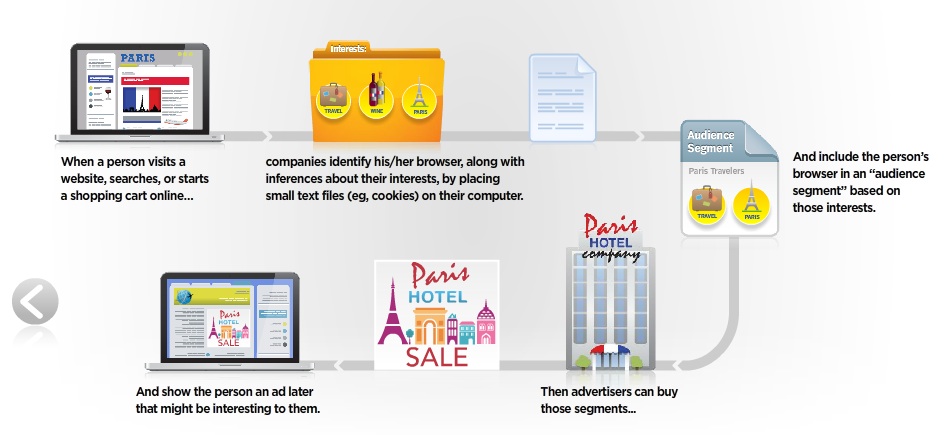
Behavioral Targeting: How to Get From ‘Creepy’ to ‘Cool’
What is Behavioral Targeting?
In general, behavioral targeting is the process of showing users advertisements (online behavioral advertisements or OBA) based on their interests, activities, and behaviors on a website. If you just thought about a tracking mechanism that follows customers around the internet seeing what they click, like, read and add to their online shopping cart, then shows them ads related to these things – you’re partially correct.

Behavioral Targeting – The Basics
Image: FAQHow
The end result of behavioral tracking is behavioral targeting. While this is a great way to drive conversions in ecommerce or online publishing by nudging customers towards an action, customers don’t always like it, and feel that their privacy is being violated by these ads.
When Is Behavioral Targeting Cool?
When it is with your permission, and when you expect it to some degree. Let’s say you sign up for a newsletter from your favourite publication or blogger. The folks use a behavioral personalization tool to recommend content to you based on what you like to read and interact with.

Image: Pocket
This is similar to a facebook news feed, and you get a great experience every day reading articles you love. This is cool because you opted in, and in turn, you received a great personalized experience.
When is Behavioral Targeting Creepy?
Anyone is creepy when they are using information you didn’t willingly give them, spying on your activities and surroundings, making suggestions about things that were private to you and offering you things you simply don’t want – no matter how relevant they are.
Let’s say you work in social media marketing. One night, while feeling some odd symptoms, you google an STD and the remedy. The next day, while you show your coworker your new social campaign, hovering on the side is an ad for an STD clinic. Embarassing – right?

Imagine if this happened in the real world. You go to a pharmacy and ask the employee there in private about the over the counter remedies for say, haemorrhoids. The next time you walk in to the pharmacy, the employee yells across the hall asking if you’re still interested in haemorrhoid creams and that he could give you a discount. Inappropriate? Bad customer service? Not cool? Totally. Yet this is exactly what online advertisers do.
How Can Marketers Find A Balance?
At the end of the day, advertisers and marketers mean well. They want to offer you products and experiences that you need and will find useful, so they use behavioral targeting. The problem is that machines mess up. They don’t understand appropriateness, embarrassment and are in general, quite lacking sensitivity.
 Now may be the right time to pitch those running shoes!
Now may be the right time to pitch those running shoes!
Image: Nittany Digital
But the silver lining here is that machines can be taught. With the rise of Artificial Intelligence, machines can slowly understand what creeps out customers and what is genuinely relevant and cool. Machines can be taught to accomodate for gender, disabilities, demographics, geographies, customers, traditions and a whole lot more before they make a pitch.
Target had an interesting experience with behavioral targeting when customer analysis told them that a number of pregnant customers could be identified based on their buying patterns. This meant that they could start marketing products particularly for pregnant women and change the content of their email marketing campaigns to reflect this.

Image: Cybersecurity.io
However, what they learnt was that sending such highly customized information to customers was a little creepy. Pregnant women weren’t excited at seeing how Target mysteriously knew that they were pregnant. Instead, they would have been creeped out. So Target decided to change their strategy. They still showed the ads for baby products and pre natal care to the women they identified as pregnant, they interspersed these ads with other products – and it worked like a charm. Behavioral Targeting can be a great way to get conversions as long as companies remember not to cross personal boundaries that they wouldn’t in the real world, offer relevant suggestions and understand their customers well before they make their offers.


